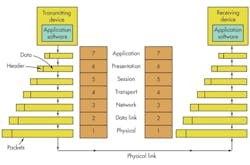CC-Link IE TSN Helps Unlock the Smart Factory’s Potential
What you’ll learn:
- Network terminology for an open system of time-sensitive networking (TSN) and insight into CC-Link IE TSN.
- Incorporating IT and OT in smart factories for maximum efficiency.
- How does the convergence of networks work on Layer 2 of the Open System Interconnection (OSI) model for communication?
Time-sensitive networking (TSN) is a game-changer for digital manufacturing applications—it’s an enabling technology to build smart, interconnected factories. It supports the convergence of multiple types of data on a single network while providing deterministic behavior and improved performance. By merging the information technology (IT) and operational technology (OT) worlds, companies can obtain unique, actionable insights into their processes and activities that can boost overall productivity and flexibility.
Anyone ready to implement TSN should not leave the existing industrial Ethernet protocols behind. These will remain critical components of network technologies for the foreseeable future when it comes to implementing the various application functions required.
As a result, to support TSN implementations, industrial automation specialists and system integrators need to leverage a network technology that incorporates TSN functions. One example is CC-Link IE TSN, the first open industrial gigabit Ethernet with TSN functions.
TSN: A Layered Approach to Industrial Communications
More precisely, TSN technology only addresses network functions at Layer 2 (Data Link) of the Open System Interconnection (OSI) model for communications (see figure). Hence, it’s only responsible for getting data from one place to another in a deterministic manner without looking at the data. What must be done with the data is typically handled at the higher-level layers that address application requirements. These are managed by specific protocols, e.g., industrial Ethernet technologies.
Since most industrial Ethernet protocols were also created to make Ethernet deterministic, the question becomes “Why do we need these and TSN, too?” The answer is to deliver convergence.
Typically, most of these protocols don’t allow for different kinds of traffic to be merged on the same network while maintaining the reliable transmission of time-critical messages. TSN takes things one step further by adding this missing capability. Therefore, the combination of the required protocols with TSN creates a system that provides all of the necessary application flexibility while enabling multiple traffic types to share the same network while being handled in a deterministic way.
Identifying the Proper Industrial Ethernet Protocols
When looking at higher-level protocols and suitable network technologies that fully leverage the advantages of a TSN-compatible protocol, machine builders and end users should look closely at its specifications. This is key to ensuring that they can address the requirements of their intended applications. Specifically, a suitable solution should encompass I/O and motion control as well as safety.
An example of a technology that can address all of these needs is CC-Link IE TSN, whose protocol uses layers 3 to 7 of the OSI reference model to build on the layer 2 TSN capabilities. By doing this, it allows for I/O, motion, and safety control to be integrated with standard TCP/IP traffic in a deterministic way. As a result, it provides the kind of transparency demanded by Industry 4.0 applications.
Building a Comprehensive Ecosystem for TSN
In addition to TSN solutions encompassing higher-level protocols, businesses should look for technologies that have a comprehensive ecosystem of development options and compatible industrial-automation products. By choosing a network technology with these features, device vendors and system integrators can make sure that they’re able to implement the solutions best suited to address their needs, no matter what kind of design approach they have in mind. In addition, they can maximize compatibility with other devices to ensure seamless communications.
For example, multiple CC-Link IE TSN development options exist to help automation vendors create highly effective and responsive devices with TSN functions. Furthermore, over 120 CC-Link IE TSN-certified devices are currently available, including state-of-the-art PLCs and drives. These are helping machine builders and end-users build next-generation industrial automation applications and advanced machines.
What Does the Future Hold with CC-Link IE TSN?
TSN is a key innovation for effective data sharing. However, it’s not a standalone solution. Higher-level protocols are needed to successfully implement innovative industrial Ethernet systems that leverage TSN, particularly to support demanding automation applications on the factory floor. CC-Link IE TSN is characterized by a strong backbone for safety communications as well as I/O and motion control.
The popularity of this solution is rapidly growing—it’s now implemented in a number of industrial settings around the world. These include manufacturing plants for automotive, food and beverage, logistics, consumer electronics, semiconductors, lithium-ion batteries, and consumer packaged goods.
In addition to supporting even the most challenging and demanding applications, CC-Link IE TSN also offers a broad spectrum of compatible devices as well as a variety of development options, both hardware and software. These contribute to the creation and utilization of TSN-compatible automation components and machines. By adopting CC-Link IE TSN, companies can rely on proven technology and truly realize the potential of TSN.
Read more articles in the TechXchange: Time for Time-Sensitive Networking.


